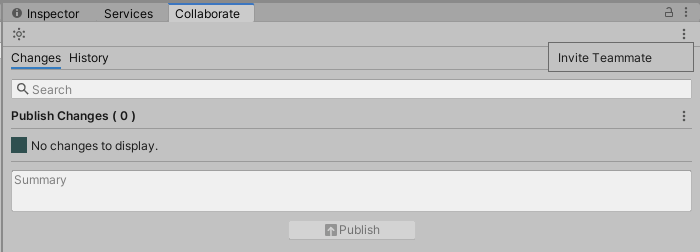Adding team members to your Unity project
Unity Collaborate is part of Unity Teams. For each person you want to collaborate with, you must assign them a Unity Teams seat in your organization.
Unity Teams is available in two versions:
- Basic, which gives you three free seats.
- Advanced, which gives you three seats, with the option to purchase additional seats.
Learn more about Unity Teams.
This page describes how to:
- Enable Collaborate for a team member
- Allow collaboration on all projects in your organization
- Allow collaboration on individual Projects
- Manage team members in your organization
- Manage Unity Teams member access
Enable Collaborate for a team member
There are two ways to enable collaboration with your team members. You can:
- Allow collaboration on all projects in your organization
- Allow collaboration on individual projects
To add team members for either of these scenarios, you must be a manager or owner of the organization that the projects are part of.
To learn how to verify your role within an organization, see Managing Your Organization.
Allow collaboration on all projects in your organization
To give a team member access to all of the projects in your organization that have Collaborate enabled:
- Make them an owner or manager of the organization. To learn how to do this, see Manage Your Organization, below.
- Give them access to Unity Teams. To learn how to do this, see Managing Collaborators in your organization, below.
For more information on enabling collaboration, see Setting up Unity Collaborate.
Allow collaboration on individual projects
To give team members access to specific projects:
- On the Unity Editor toolbarA row of buttons and basic controls at the top of the Unity Editor that allows you to interact with the Editor in various ways (e.g. scaling, translation). More info
See in Glossary, click the collaborate button. - In the Collaborate panel, click the More icon (⋮).
- Click Invite Teammate.
 Unity launches the Users section of the Unity Developer Dashboard in your browser. From the Users section, you can invite anyone with a Unity ID to join your project:
Unity launches the Users section of the Unity Developer Dashboard in your browser. From the Users section, you can invite anyone with a Unity ID to join your project:

- Select Also assign a Unity Teams Seat to this user.
- To add the user as a guest in your organization, click Add. This assigns a Unity Teams seat to the user.
The team member who you’ve given access to the project will now be able to see the project in the Unity Hub.
Downloading projects in the Unity Hub
The Unity Hub displays projects in your organization that you have access to, which you don’t already have on your local machine. To download the project, click the cloud icon in the Unity Hub.

Manage team members in your organization
Manage team members in the Organizations page of the Unity ID website. To manage team members:
- Sign into Unity ID.
- On the left-hand side of the page, click Organizations.
- Select your organization.
- On the left-hand side, select Members & Groups.
The Members & Groups view lets you see the members of your organization, and their roles. Users can have one of the following roles:
- Owner
- Manager
- User
- Guest
Organization owners can change the roles of all members, and add and remove members of all roles.
Organization managers can change the roles of managers, users, and guests, and add and remove members of these roles.
For more information, see What can Owners, Managers and Users do in my Unity Organization?.
Manage Unity Teams member access
To access Collaborate and Cloud BuildA continuous integration service for Unity projects that automates the process of creating builds on Unity’s servers. More info
See in Glossary functionality, your team members must have access to Unity Teams. To check your team members’ access:
- Sign into Unity ID.
- On the left-hand side of the page, click Organizations.
- Select your organization.
- Click Subscriptions & Services.
- Select your Unity Teams subscription and click Manage seats.
This opens a page which allows you to assign Unity Teams seats to members of your organization. To view which team members have a Teams seat, select Assigned.
To assign a seat to a user, select the user and click Assign Seat(s).
2017–12–01 Page published
2017–12–01 - Service compatible with Unity 2017.1 onwards at this date but version compatibility may be subject to change.
New feature in 2017.1